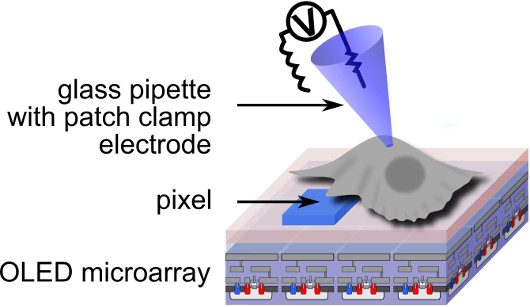Scientists at the University of St Andrews have discovered that the lighting used in smartphone displays can activate live cells that are genetically programmed to respond to light.
Professor Malte Gather from the School of Physics and Astronomy, who led the research, describes the findings as “a bit like cells watching TV”.
Harnessing the ability of organic light emitting diodes (OLEDs) to “turn on” individual cells in the lab paves the way for cell-specific optogenetic control in cultured neuronal networks, brain slices, and other biomedical research applications.
 |
|
Professor Gather and co-workers at the University of St Andrews used a miniature version of the OLED displays found in modern smartphones to illuminate individual live cells. For cells that are genetically programmed to embed a light-gated ion-channel in their membrane, this facilitates lens-free optical switching of the membrane current with single-cell resolution. (All images courtesy of University of St. Andrews) |
Working with Dr Gareth Miles from the School of Psychology and Neuroscience, Professor Gather and his team used OLEDs to manipulate individual, live cells from a human embryonic kidney cell line that were tweaked to produce a light-sensitive protein. Upon exposure to blue OLED light from pixels directly underneath the cell, the electric activity of individual targeted cells was stimulated, while neighbouring cells remained in the dark and stayed inactive.
The team used a standard cell line to test their approach, but the goal is to apply the technology to activate individual neurons or groups of neurons, which would facilitate new ways of studying neuronal network function in the lab and ultimately advance knowledge of the neuronal dysfunction that underlies devastating neurodegenerative conditions such as Alzheimer’s Disease, Parkinson’s Disease and Motor Neurone Disease.
 |
|
A diagram of the OLED microarray solution used by the University of St Andrews research team. |
The results suggest that OLEDs are an ideal platform technology for investigating and controlling biological processes with single cell resolution.
Professor Gather said: “Using a miniature version of the OLED displays used in modern smartphones, we can now expose individual cells to light and thereby activate them in a controlled fashion.
“We hope to apply OLED technology to study processes in networks of neurons in a new way. Depending on which picture we show to the network, we expect to see different responses and thus better understand how the cells are linked within the network. A principal advantage of the lens-free OLED approach is the capability to perform multiple experiments in parallel and without damage to the cells.”













